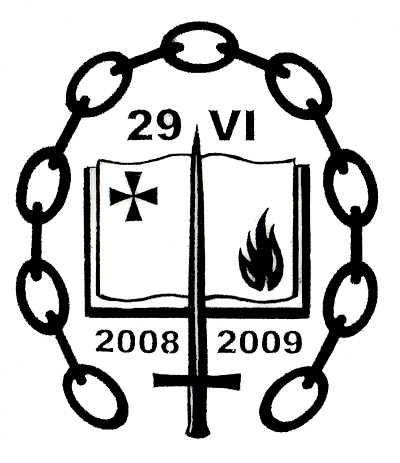A few months ago, Pope Benedict announced a “Pauline Year” beginning on June 29, 2008 and running until, naturally enough, June 29, 2009.

This morning, a press conference was held outlining some planned activities for the year and suggestions for activities at the level of the local church. The official Vatican report on the press conference is only in Italian at this point, but we’ll be looking for English reports.
There are a couple of nifty websites up – still in the process of being constructed, and not yet translated into any language other than Italian, but here they are:
A site dedicated to the Basilica of St. Paul-Outside-the-Walls
The site for the Pauline Year, specifically.
Also watch for Pope Benedict’s participation in the annual celebration of Vespers at the Basilica on Friday, the Feast of the Conversion of St. Paul – an ecumenical celebration as it also closes out the Week of Prayer for Christian Unity.
A summary from VIS:
Participating in today’s press conference were Cardinal Andrea Cordero Lanza di Montezemolo, archpriest of St. Paul’s Outside-the-Walls, Fr. Johannes Paul Abrahamovicz, prior of the basilica’s abbey, and Piero Carlo Visconti, of the administrative offices.
Cardinal Cordero Lanza di Montezemolo remarked how Pope Benedict had called the Pauline year during the celebration of first Vespers for the Solemnity of Sts. Peter and Paul on 28 June 2007, in order to commemorate the second millennium of the birth of the Apostle of the Gentiles. On that occasion, the Pope had highlighted the ecumenical dimension of the event because St. Paul “was particularly committed to bringing the Good News to all people, and made prodigious efforts for the unity and harmony of all Christians”.
The cardinal explained how the Pauline year “will provide an occasion” to undertake various activities: “rediscover the figure of the Apostle; reread the numerous Letters he sent to the first Christian communities; relive the early years of our Church; delve deeply into his rich teaching to the ‘gentiles’; meditate on his vigorous spirituality of faith, hope and charity; make a pilgrimage to his tomb and to the numerous places he visited while founding the first ecclesial communities; revitalise our faith and our role in today’s Church in the light of his teachings; pray and work for the unity of all Christians in a united Church”.
Scheduled activities include a pastoral programme (daily ordinary and extraordinary liturgical celebrations, meetings for prayer and the Sacrament of Penance); a cultural religious programme (catecheses on St. Paul, conferences, congresses, concerts); pilgrimages (to the basilica and to other Pauline sites in and outside Rome); a cultural artistic programme (exhibitions, publications, postage stamps, the coining of a special medal, the issue of a stamp and a two euro coin by the Governorate of Vatican City State); a publishing programme (a guide to the basilica of St. Paul’s Outside- the-Walls to be published in various languages, a new edition of the Acts of the Apostles and of the Letters of St. Paul, and the opening of a site www.annopaolino.org constantly updated with information relating to the event).
Finally, the cardinal turned his attention the ecumenical programme, ecumenism being an important aspect of the Pauline Year. He announced that the chapel currently used as the baptistery, located between the basilica and the cloister of St. Paul’s Outside-the-Walls, will become the “Ecumenical Chapel, maintaining its characteristic baptismal font but designated as a place in which to offer our Christian brethren a special place for prayer, either within their own groups, … or together with Catholics, without the celebration of the Sacraments”.
This chapel will also be used to house the remains of St. Timothy of Antioch and of other unknown forth century martyrs, which were discovered in the hypogeum of St. Paul during restoration work on the basilica in 2006.

